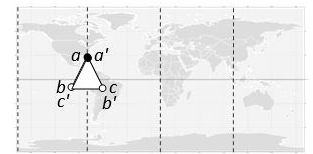Question 13
(Multiple Choice)
We can try to map the surface of a globular protein in two dimensions just like we depict the surface of the Earth in a world map. On such a map, the binding site of a molecule for other molecules of the same protein (for assembly into a multisubunit complex) can be marked. In the following "maps," two molecules of the protein can bind if the points a, b, and c on the surface of one molecule can align to points a′, b′, and c′ in the other molecule, respectively. Which map corresponds to a protein whose assembly gives rise to a helix? Hint: the other maps correspond to a dimer, a ring, and a linear filament.
A)

B)

C)

D)

Answer